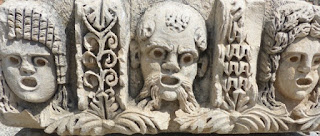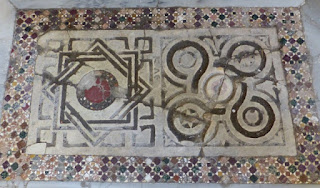SALLY
Our
friend Alison stepped off the ferry 10 or so days ago into oh-so seductive Symi.
Venetian houses in shades of ochre, pastel blue, violet, yellow, pink tumble down
the hill, framing the harbour of Gialos. Almost too beautiful to bear, Alison
was seduced within moments – and that was before meeting the warm and generous
people we have been raving about for 4 years.
The
first night we took her to dinner at our favourite family run taverna – only to
be met by Papa spitting mad, tipping a plate of delicious looking fish into the
sea and shouting at a shaken looking couple – who had apparently dared to
complain about his food. We sat down a little hesitantly amidst the tirade, but
as soon as the offending patrons had skulked off, Papa delivered two excellent
bottles of wine to our table “from me, apologies for the bad welcome”.
We
ordered a few of our favourite dishes and relaxed into the ambience.
Symi
shrimps – tiny, crispy and succulent, sweeter than any fat Mozambiquan prawn we
have ever eaten. And feta cheese wrapped in filo pastry, deep fried, smothered
in sesame seeds and honey with a drizzle of lemon juice – heavenly! Wandering
home along the waterfront to our bobbing boat that evening we could see that
Alison was thoroughly captivated.
We
have realized that so many of our special moments happen when we are in
tavernas, ouzeries or cafes. The laid
back ambience encourages us to ease into the local culture and chat to the
owners or other diners. Alison’s second night with us was not disappointing. We
had gone for a lunchtime beer to a tiny traditional kafenion / ouzerie in a
cool courtyard covered with a thick vined pergola. The Mythos quarts were
delivered, along with a complimentary plate of delcious meze – dolmades with
fluffy Greek yoghurt, a melanzane vegetable dish, fava beans, hummous and thick
slices of crusty bread. Our surprise and delight was evident – “this is natural
– you drink something here, we serve you mezes. But we would like you to come
back in the evening sometime. You might even hear some music”…….
So
we did – the next night we booked a table painted with a winsome mermaid and
arrived to a warm welcome. Within minutes we felt as if we had been transported
into some kind of Greek drama. Owner and self-proclaimed chef, waiter,
musician, dishwasher, Mercurious,
was dashing between guitar, kitchen and patrons; Philemon with the sleepy eyes
and deep husky-honey voice was playing bouzouki and singing with a passion that
shook all three of us and moved us to tears; young Theodore was dancing,
playing bouzouki and singing with intense emotion.
This
time we ordered a large plate of delicious mezes and carafes of wine which we devoured
in the incredibly romantic atmosphere, joined by our new French friend,
Martine, who had been sitting alone behind us.
Mercurous, Philemon and Theodore play Rebitika music – songs of the Greek underground.
In the 1920’s, two million refugee Greeks from Aisa Minor arrived in a country
they had never lived in and which could not support them. In cafes and hash
dens around Greece Rebetika was formed – it was the language of these outcasts
and spoke of loss, oppression, pain, poverty, betrayal, and unrequited love. It
was the Greek urban blues.
As
Philemom sang passionate song after passionate song, Mercurious adopted us,
plying us with his smooth but fiery raki that seemd to have no end. With a
clash of glasses and a yammas, each downing of a raki got the 4 of us more and
more entranced. At about midnight, Mercurious raided the kitchen (his wife Anna
had long gone home) and produced bread, feta, olives, spicy salami and strips
of smoked beef. With our stomachs now well lined, we downed more raki and
surrendered ourselves to this impossibly beautiful night. At 2am we hugged and
kissed our new friends for life and wandered in a daze of warmth and camaraderie
down the deserted quay.
Zembekiko sounds like it is a song about a bad girlfriend, but it is really about the dreaded military police which tortured anyone suspected of being a dissident.
Frankosyriani is a
song about a Catholic girl from Syros – unusal in this predominantly Greek
Orthodox country.
If you are interested in Rebetika (and all things Greek), read Matt Barret's marvellous website: http://www.greecetravel.com/music/rembetika/
ALISON
One
of the most moving experiences of this wonderful trip with Sally and Henry was
our encounter with a bunch of Syrian migrants. I had been reading about them in
the UK press – dozens of Syrians fleeing across the border into Turkey and then
crammed into small boats they wobble across the sea arriving in Greek
territory, many of them landing on
the little island of Kos. Clutching small backpacks they have been sleeping on
the streets of Kos, apparently
causing irritation to the British tourists.
But here
we are on the island of Tilos, the day as usual febrile with the paradoxical
sense of adventure and lethargy. After a bus trip to Megalo Hora – where we
visited the renowned Greek artist Angeliki Stringou – and then to the little
harbour of Agios Nikolaos – we returned to our Tilos harbour base and became
aware of groups of mainly men with small rucksacks all with a brand new
sleeping bag dangling in its little bag, sitting waiting, chatting, smoking.
Meanwhile I reflected on the day. Angeliki Stringou – in her 80’s –
is petite, wizened, a fringe of dark red hair framing her face, wearing a
bright orange T shirt . We climbed
right up to the top of the village, up steep winding stairs to her small home
perched on a ledge next to the church. She welcomed us in and showed us
folders of watercolours capturing so deftly the essence of Greece. Needless to
say I left with a couple!
And
Agios Nikolaos – our lunch spot – a tiny fishing harbour, a few small tables with brightly
checked orange and white tablecloths, cold beers in the shade of the ubiquitous
tamarisk trees and a lunch of note – Madame, or “Kryia” in Greek – served us
her freshly made dolmades, still warm, tiny, moist and utterly delicious,
served with tzstsiki made with the thick fluffy Greek yoghurt impossible to replicate in South Africa. A good
Greek salad and some fried squid caught by Papa completed the meal.
Then
to sketch and a quiet hour or so with all three of us utterly absorbed in our
attempts to capture the scene, totally relaxed by the beers and the heat of the
day.
Later
back in Tilos harbour a sudden flurry of movement – the evening ferry was
coming in and the slender dark men and women with backpacks and sleeping bags
swarmed down to board the Athens bound ferry. Each one in turn lined up to embrace a middle aged English
woman who was wishing them well with tears in her eyes. I spoke to one young
man who confirmed our suspicions, they were indeed Syrian migrants fleeing from
the terror of war. He told us that fifty of them had come over to Tilos a
couple of days before, crammed into a tiny boat. He had come with his brother but his mother and the rest of his family had remained behind in Syria, and he was hoping to get to Sweden.
It
was an incredibly moving and emotional sight – a trail of Syrians embracing the
English woman – cell phones whipped out to take farewell pictures and suddenly we were included in a selfie. The three of us were now in tears with the sheer
emotion of the enormity of it all. Later we chatted to the Englishwoman and her
husband – they had helped to care for the migrants on a volunteer basis and had
been doing so for a couple of years. International aid organisations appear to
have provided some funds and the sleeping bags.
Heart rending stuff this, and certainly gave me pause for thought about the bigger picture and that ever precarious balance between tragedy and joy.
Heart rending stuff this, and certainly gave me pause for thought about the bigger picture and that ever precarious balance between tragedy and joy.




































































